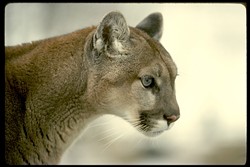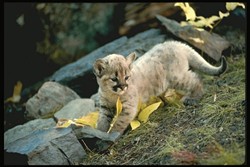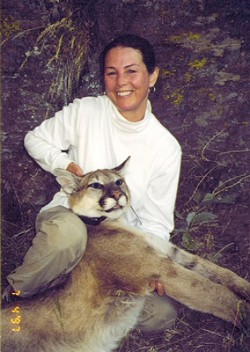We live in cougar country, sharing the landscape with a mysterious and magnificent animal that few of us will ever see. For thousands of years, America’s lion has evoked a wide range of human emotions, from fascination to fear.Â
Â

- PHOTO COURTESY OF MOUNTAIN LION FOUNDATION
- AMERICA’S LION : These secretive, solitary predators require large areas of natural habitat with deer, and prefer to avoid humans.
Â
“Of all the animals in the woods, mountain lions are the most beautiful, the symbol of wildness for me. I think as long as there are large unbroken tracts of land in the county, ranchland and public land, they’ll live and survive alongside us,� says Santa Margarita horseman Bob Stone, an expert at tracking the big cats.
Â
Cougar, panther, puma, mountain lion—these are just a few of the many names for the same stealthy hunter, whose preferred diet is deer. Mountain lion mealtime may also feature elk, wild pigs, turkeys, rabbits, skunks, and an assortment of other wild animals. “Yes, in fact, they can eat us,� says Michelle Cullens, director of the nonprofit Mountain Lion Foundation’s conservation program. “If mountain lions wanted to eat people, we’d be an incredibly abundant food source for them.�
Â
Fortunately for us, they prefer to completely avoid people, not eat them. They’re much more interested in deer, their main food source for thousands of years. As George Herbert wrote back in the 1600s, “A lion is not so fierce as they paint him.� Attacks on humans are very rare, with fewer than two dozen recorded deaths by mountain lions in North America in 115 years, according to Cullens. You’re far more likely to end up in the emergency room from an encounter with a vending machine or a golf ball or even a pillow, her statistics show.
Â
Mountain lions can reach speeds of 50 mph in a sprint, leap 40 feet in a single bound, and walk for miles at 10 mph. Adults can be up to eight feet long including their tail, stand two or three feet tall, and weigh 80 to 180 pounds.
Â

- PHOTO COURTESY OF MOUNTAIN LION FOUNDATION
- THE YOUNG LIONS : Mountain lion kittens, like their mother, need meat to survive. Three-fourths of young lions don’t live to see their second birthday.
Â
Each mountain lion needs its own vast territory for hunting, and moves around its territory constantly. “Meat is the only way they can survive,� Cullens explains.
 Â
 Kittens stay with their mother for up to 18 months before dispersing to try to establish their own territories, and 75 percent of the young animals die within the first two years of life. An older, dominant male may kill a younger male that tries to move into his territory, studies show.
Â
In Suzanne Nichols’ kindergarten classroom at Hawthorne School in SLO, the kids play a game where they pretend to be mountain lions dispersing from one area to another, encountering highways and houses that make their movement difficult. Following state standards for life sciences education, Nichols also teaches the kindergartners how mountain lions kill their prey, and how to be safe if they’re walking in lion country. They learn to recognize a mountain lion track, with its distinctive M-shaped pad “like Batman wings.�
Â
Nichols is passionate about the big cats, ever since she participated in an Earthwatch scientific expedition where she helped put radio tracking collars on mountain lions. “I was mesmerized by the experience. It’s the dream of a lifetime to actually hold a mountain lion, an exquisitely elegant animal,� she says with a smile.
Â
“The kids in my class are the next generation to take care of the earth. These animals are America’s lion, their heritage. The more information they have, the more compassion they have for living with wildlife,� Nichols adds.
Â
State Fish and Game wildlife biologist Bob Stafford says he’s seen a mountain lion in the wild twice, “both times, the backside and tail of a lion running away.� He adds, “If I’ve seen two, 100 have seen me. It thrills me to see them. I hope my kids will be able to see them in the future. And I also want my kids to be safe. We can work it out.�
Â
The number of mountain lion attacks on humans is “infinitesimal,� Stafford says, adding, “Certain parts of the population overplay the potential threat, like ‘Oh, my gosh, there’s one behind every bush.’ That’s not true. We face far greater threats with cars every day.� He recommends keeping livestock in safe enclosures and discouraging deer from your yard. “The biggest challenge is private land conversion. As goes the deer population, so goes the lion population.�
Â

- PHOTO BY CHRISTOPHER GARDNER
- LEARNING ABOUT LIONS : Kindergarten students in Suzanne Nichols’ class at Hawthorne School enjoy acting like mountain lions as part of their studies.
Â
Corrina Jones, a resident of west Atascadero, watched people in her neighborhood put out food and saltlicks for deer, which began gathering in herds every evening in local yards for their handout. It wasn’t long before the opportunistic mountain lions showed up as well, finding unprotected goats and sheep easy prey too.
Jones was surprised to discover that the unlucky livestock owners had the right to seek a “depredation permit,� a targeted approach where the offending mountain lions were killed at taxpayers’ expense. Soon, another lion moved into the territory, following the deer.
Â
“They’re opportunistic hunters trying to survive,� Jones says. “Killing a mountain lion doesn’t resolve the conflict, because as soon as one mountain lion is gone, another will move into the territory. It seems like modifying our behavior is the answer.� She’s working to educate residents of rural Atascadero about precautions they can take: “Don’t feed wildlife, don’t plant plants that deer like to eat, bring your cats inside at night, secure your dogs, make sure your goats and sheep are in barns or enclosures.�
Â
Lynn Sadler, president of the Mountain Lion Foundation, agrees that killing a mountain lion is not the best solution, because the territory becomes open for another. “Maybe a less mature male will come in, and they’re the most likely to have conflicts with humans. Maybe they’re not good at killing deer yet. A hobby goat tied in a field is like setting out bait for a mountain lion, or maybe a poodle gets in the way when a young male is going after a female across the canyon. The best thing to do if you see one is to go inside and wait for the lion to move on. A lot of people feel that if you see one, you’re in danger and it needs to be killed, but that’s not the case. Mountain lions make their living by staying out of sight, but with more people around, it’s more difficult for them to stay out of sight.�
Â
Sadler emphasizes that there is an “urgent� need to protect mountain lions, which—as the top carnivores—are considered a “keystone species� for our environment. “When you remove a top carnivore, you see a trophic cascade of extinction. The landscape could look very different. That’s a gamble most people don’t want to take.�
Â
Local Fish and Game warden Todd Tognazzini
says calls about mountain lion sightings in SLO County have increased “dramatically,� especially in residential areas where deer are attracted to irrigated lawns and lush ornamental plants. In the last few weeks, Tognazzini has issued two different depredation permits for mountain lions that attacked unprotected sheep and goats at rural ranchettes near expanding vineyards. Depredation permits have doubled in recent years, he says.
Â
“Conversion of ranchland has a huge impact on all wildlife,� the warden points out. Unfenced vineyards can attract deer to feed on the grapevines, followed by mountain lions. Fenced vineyards block deer corridors and remove an entire area from the habitat, he says, adding, “In the bigger picture, parceling up of land is by far the biggest impact.�
Â

- PHOTO COURTESY OF SUZANNE NICHOLS
- YOU CAN’T HIDE YOUR LION EYES : Scientists are finding out about the secret life of mountain lions, using radio tracking collars like this one fitted on a tranquilized big cat by SLO teacher Suzanne Nichols.
Â
The latest management guidelines point out that there are still many unknowns and uncertainties. No one knows how many mountain lions there are, for example. The number one recommendation: Large landscapes of “well-connected habitat with thriving natural prey populations are necessary for healthy, self-sustaining mountain lion populations.�
Â
San Luis Obispo County is in the spotlight. The Mountain Lion Foundation recently obtained a grant aimed at reducing mountain lion deaths, taking into account the conversion of ranchland and habitat. Explains Sadler, “We need to look at where mountain lion conflicts occur. Are they primarily in certain landscapes? What are the common factors? What education makes the most sense?�
Â
Cullens asks, “Are we seeing more lions because there are more lions? Or because they’re not in the wilderness anymore? We want to learn about the way land is used in SLO County and the way people feel about it. Right now there’s plenty of room for wildlife and people in the county. We hope to devise a method to allow people to live in better harmony with mountain lions and their prey. That may mean living farther apart, so there are places where humans feel safe, and places where wildlife feels safe. We can all learn from San Luis Obispo County.�
Â
Warden Tognazzini urges local residents to learn as much as possible about the secretive cats. “Folks need to understand more about mountain lions.� For Stone, it’s simple. “We tend to be against that which we know least about. Knowledge is comforting.� ∆
Top ten tips for staying safe in cougar country
1. Don’t feed wildlife such as deer, raccoons or turkeys. These prey animals attract predators.
2. Design your landscape with plants that don’t attract deer.
3. Keep your pets and their food indoors between dusk and dawn.
4. Secure your livestock in predator-proof enclosures, especially between dusk and dawn.
5. Don’t hike alone, especially at dawn or dusk.
6. Keep children very close to you. If you encounter a mountain lion, pick up small children immediately, without crouching down.
7. Do not run. Maintain eye contact and back away.
8. Raise your arms to appear as large as possible; raise your jacket over your head so you look more like a grizzly bear than a deer. Speak loudly.
9. Throw sticks, rocks or other objects if accessible without bending too low.
10. If attacked, fight back.
Award-winning journalist Kathy Johnston may be reached at [email protected].
Comments